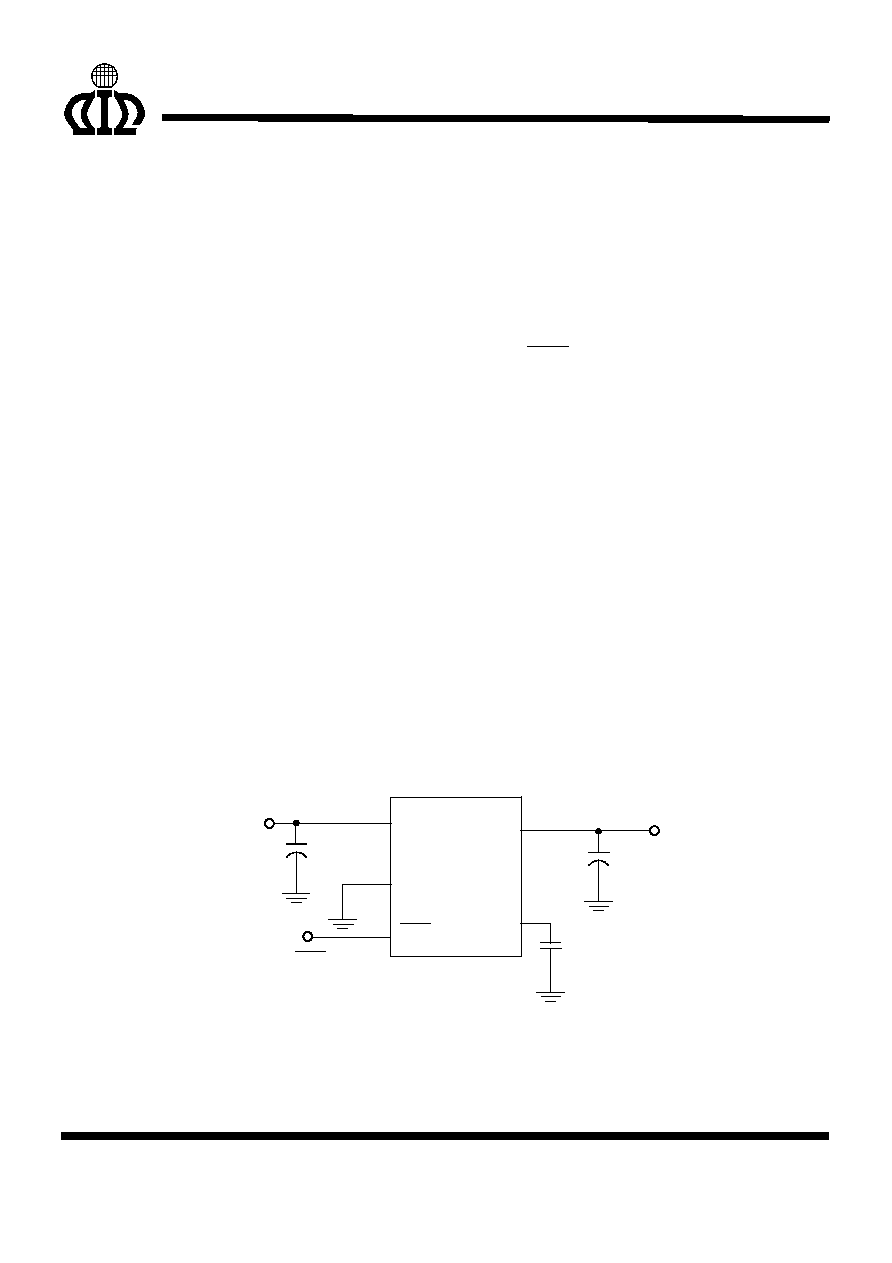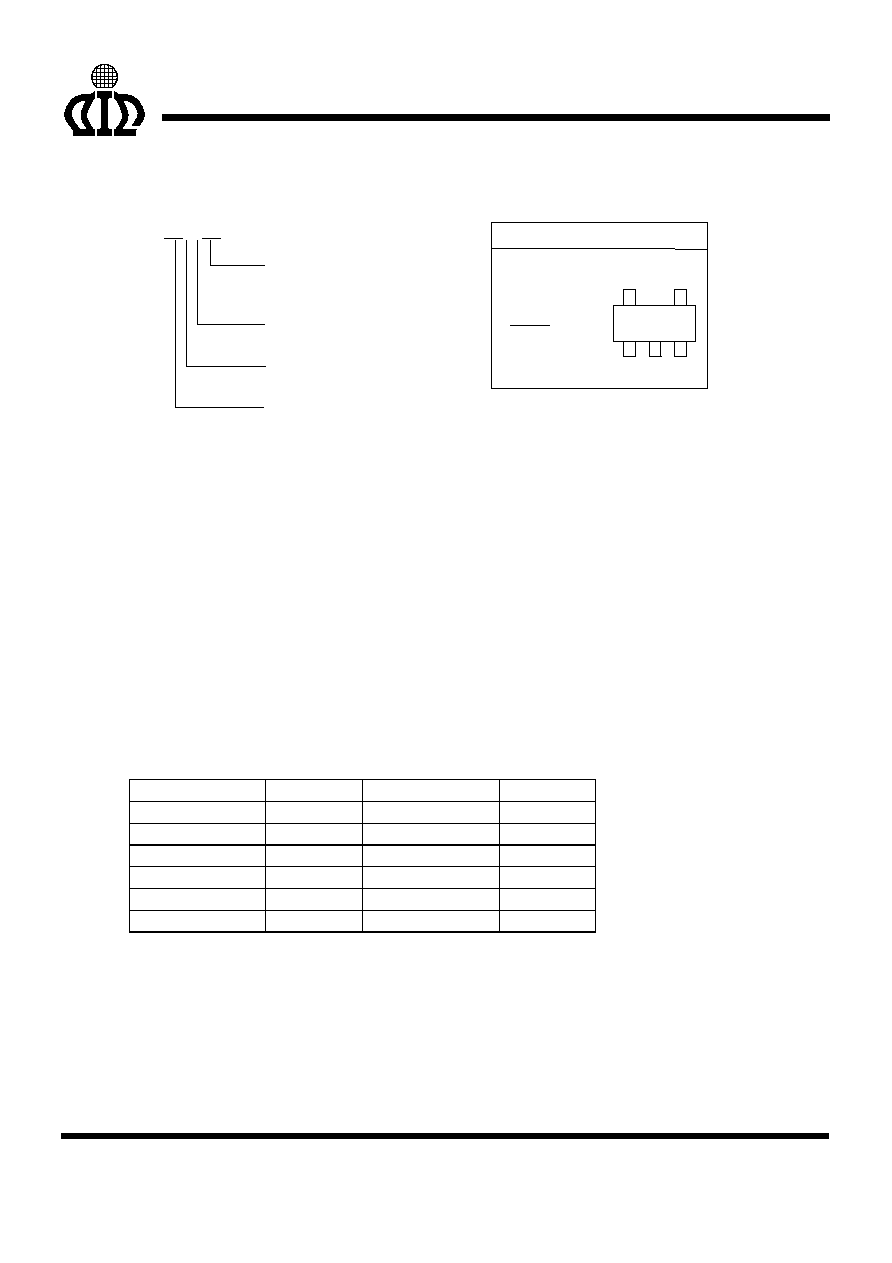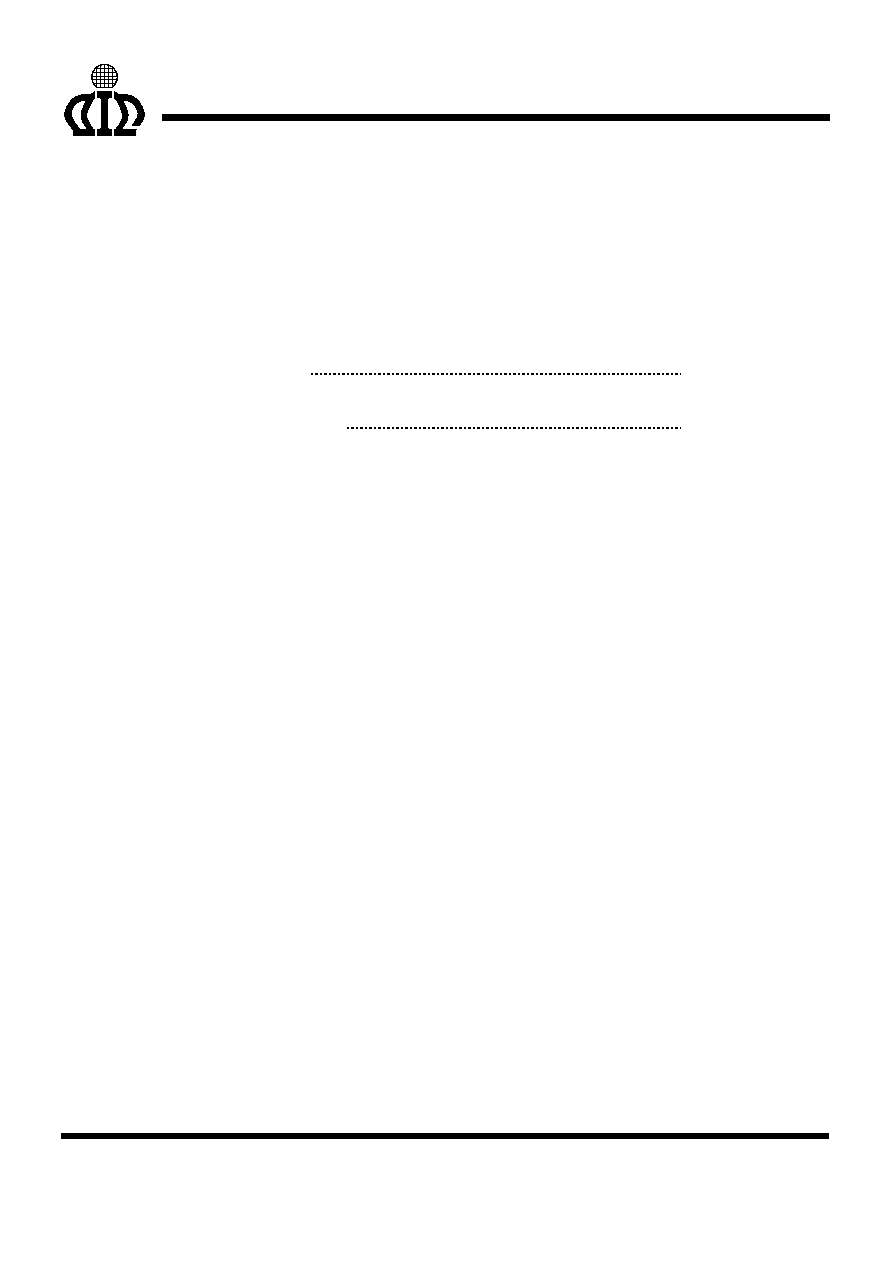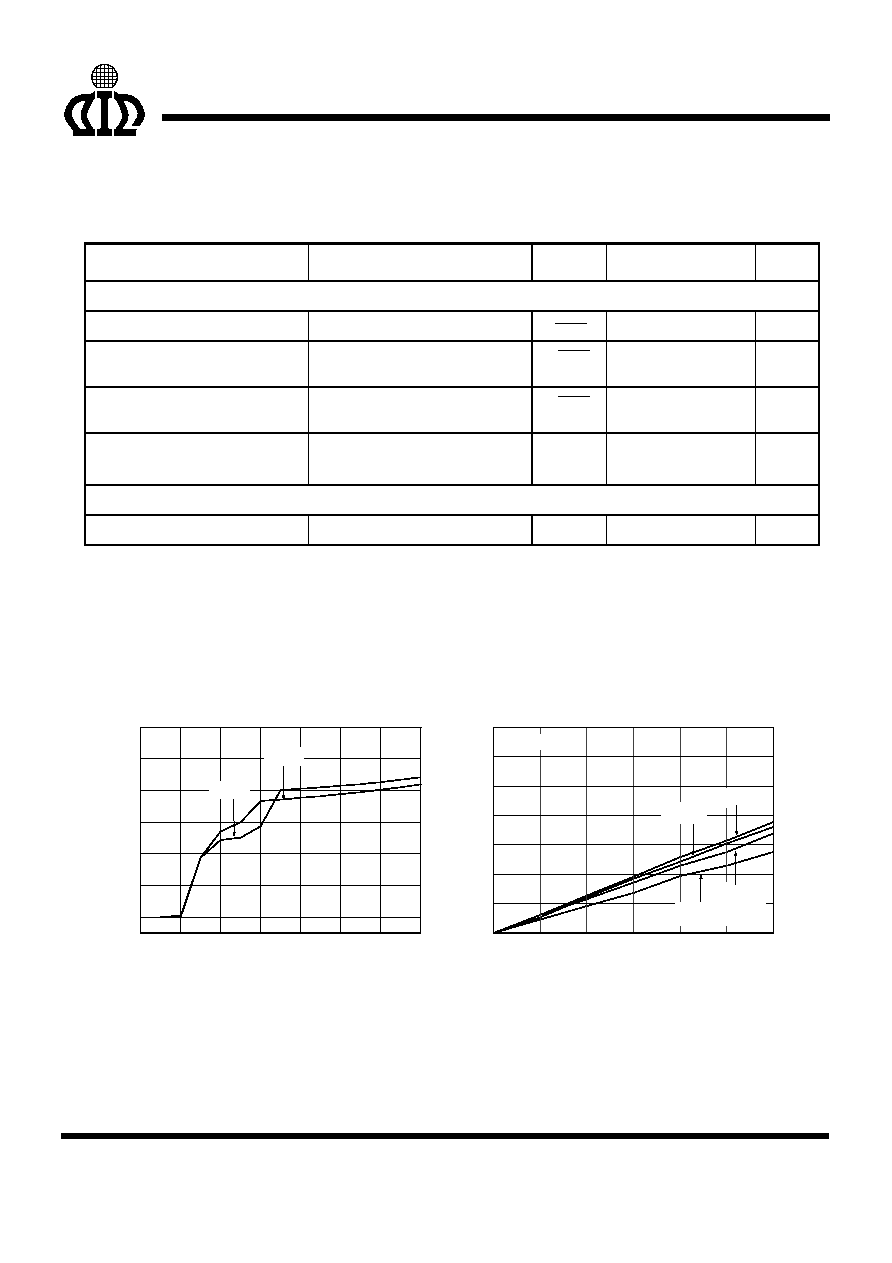
AIC1731
300mA, Low Dropout Linear Regulator with Shutdown
Analog Integrations Corporation
Si-Soft Research Center
DS-1731P-03 092304
3A1, No.1, Li-Hsin Rd. I , Science Park , Hsinchu 300, Taiwan , R.O.C.
TEL: 886-3-5772500
FAX: 886-3-5772510
www.analog.com.tw
1
FEATURES
Active Low Shutdown Control.
Very Low Quiescent Current.
Very Low Dropout Voltage of 470mV at 300mA
Output Current (3.0V Output Version)
1.5V, 1.8V, 2.5V, 2.8V, 3.0V, 3.3V Output Voltage.
Short Circuit and Thermal Protection.
±2% Output Tolerance.
Miniature Package: SOT-23-5
APPLICATIONS
PDA
DSC
Notebook
Pagers
Personal Communication Equipment
Cordless Telephones
Portable Instrumentation
Portable Consumer Equipment
Battery Powered Systems
DESCRIPTION
AIC1731 is a 300mA low noise, low dropout
linear regulator, and is housed in small SOT-23-5
package. The device is in the "ON" state when
the SHDN pin is set to logic high level. An
internal P-MOSFET pass transistor is used to
achieve 470mV low dropout voltage at 300mA
load current. It offers high precision output
voltage of
±2%. The quality of low quiescent
current and low dropout voltage makes this
device ideal for battery power applications. The
internal reverse bias protection eliminates the
requirement for a reverse voltage protection
diode. The high ripple rejection and low noise of
AIC1731 provide enhanced performance for
critical applications. The noise bypass pin can be
connected an external capacitor to reduce the
output noise level.
TYPICAL APPLICATION CIRCUIT
C
IN
1
µF
V
IN
BP
VOUT
SHDN
GND
VIN
AIC1731
C
OUT
1
µF
C
BP
0.1
µF
V
SHDN
V
OUT
+
+
Low Noise Low Dropout Linear Regulator

AIC1731
ORDERING INFORMATION
PACKING TYPE
TR: TAPE & REEL
BG: BAG
PACKAGE TYPE
V: SOT-23-5
C: COMMERCIAL
P: LEAD FREE COMMERCIAL
OUTPUT VOLTAGE
15:
1.5V
18:
1.8V
25:
2.5V
28:
2.8V
30:
3.0V
33:
3.3V
AIC1731-XXXXXX
PIN CONFIGURATION
SOT-23-5 (CV)(PV)
TOP VIEW
1: VIN
2: GND
3: SHDN
4: BP
5: VOUT
3
2
1
4
5
(Of a unit of 0.1V within the voltage range from 1.5V to 3.3V, additional
voltage versions for this product line may be available on demand with
prior consultation with AIC.)
Example: AIC1731-18CVTR
1.8V Version, in SOT-23-5 Package & Tape & Reel
Packing Type
AIC1731-18PVTR
1.8V Version, in SOT-23-5 Lead Free Package & Tape &
Reel Packing Type
∑
SOT-23-5 Marking
Part No.
Marking
Part No.
Marking
AIC1731-15CV ED15 AIC1731-15PV ED15P
AIC1731-18CV ED18 AIC1731-18PV ED18P
AIC1731-25CV ED25 AIC1731-25PV ED25P
AIC1731-28CV ED28 AIC1731-28PV ED28P
AIC1731-30CV ED30 AIC1731-30PV ED30P
AIC1731-33CV ED33 AIC1731-33PV ED33P
2

AIC1731
ABSOLUTE MAXIMUM RATINGS
Supply Voltage
................................................................................................12V
Shutdown Terminal Voltage ...............................................................................12V
Noise Bypass Terminal Voltage
............................................................................5V
Operating Temperature Range
...............................................................-40∫C~85∫C
Maximum Junction Temperature
125
∞C
Storage Temperature Range
...................................................................-65∫C~150∫C
Lead Temperature (Soldering, 10 sec)
260
∞C
Thermal Resistance (Junction to Case) SOT-23-5
........................................130
∞C /W
Thermal Resistance Junction to Ambient
SOT-23-5 ........................................220
∞C /W
(Assume no ambient airflow, no heatsink)
Absolute Maximum Ratings are those values beyond which the life of a device may be impaired.
TEST CIRCUIT
Refer to TYPICAL APPLICATION CIRCUIT
3

AIC1731
ELECTRICAL CHARACTERISTICS
(C
IN
=1
µF, C
OUT
=4.7
µF, T
J
=25
∞C, unless otherwise specified) (Note1)
PARAMETER
TEST CONDITIONS
SYMBOL MIN. TYP. MAX.
UNIT
Quiescent Current
I
OUT
= 0mA, V
IN
= 3.6~7V
I
Q
35
50
µA
Standby Current
V
IN
= 3.6~7V, output OFF
I
STBY
0.1
µA
GND Pin Current
I
OUT
= 0.1~300mA
I
GND
30
50
µA
Continuous Output Current
V
IN
= 5V
I
OUT
300
mA
Output Current Limit
V
IN
= 5V, V
OUT
= 0V
I
IL
300
450 mA
Output Voltage Tolerance
V
IN
= 5V, no load
V
OUT
-2 2 %
Temperature Coefficient
TC
50
150
ppm/∫C
Line Regulation
V
IN
= V
OUT(TYP)
+ 1V to 7V
V
LIR
3 10 mV
Load Regulation
V
IN
= V
OUT
+ 1.2V (Vout 2.0V)
V
IN
= V
OUT
+ 1.7V (Vout 1.9V)
I
OUT
= 0.1~300mA
V
LOR
10 30 mV
Dropout Voltage
I
L
=300mA
3.0V
V
OUT
3.3V
2.5V
V
OUT
2.9V
2.0V
V
OUT
2.4V
1.5V
V
OUT
1.9V
V
DROP
470
570
800
1260
870
970
1200
1660
mV
Noise Bypass Terminal Voltage
V
REF
1.23
V
Output Noise
C
BP
= 0.1
µF, f = 1KHz,V
IN
= 5V
n
0.46
Hz
V
µ
Ripple Rejection
f = 1KHz, Ripple = 0.5V
P-P
,
C
BP
= 0.1
µF
RR 55 dB
4

AIC1731
ELECTRICAL CHARACTERISTICS
PARAMETER
TEST CONDITIONS
SYMBOL MIN. TYP. MAX.
UNIT
SHUTDOWN TERMINAL SPECIFICATIONS
Shutdown Pin Current
I
SHDN
0.1
µA
Shutdown Pin Voltage (ON)
Output ON
V
SHDN
(ON)
1.6 V
Shutdown Pin Voltage (OFF)
Output OFF
V
SHDN
(OFF)
0.6 V
Shutdown Exit Delay Time
C
BP
=0.1
µF, C
OUT
=1
µF,
I
OUT
=30mA
t
300
µS
THERMAL PROTECTION
Thermal Shutdown Temperature
T
SD
155
∫C
Note 1: Specifications are production tested at TA=25
∞C. Specifications over the -40∞C to 85∞C operating
temperature range are assured by design, characterization and correlation with Statistical Quality
Controls (SQC).
TYPICAL PERFORMANCE CHARACTERISTICS
0
1
2
3
4
5
6
7
0
10
20
30
40
50
60
Fig. 1 Quiescent Current vs. V
IN
3.3V
1.5V
Q
u
ies
c
ent Cur
r
ent
(
µ
A
)
V
IN
(V)
V
DR
OP
(mV
)
Fig. 2 V
DROP
vs. I
LOAD
0
50
100
150
200
250
300
0
100
200
300
400
500
600
700
AIC1731-33
T=80
∞C
T=50
∞C
T=20
∞C
T=-40
∞C
I
LOAD
(mA)
5

AIC1731
TYPICAL PERFORMANCE CHARACTERISTICS
(Continued)
G
r
ound C
u
rr
ent (
µ
A)
I
LOAD
(mA)
0
50
100
150
200
250
300
39.0
39.5
40.0
40.5
41.0
41.5
42.0
42.5
43.0
43.5
44.0
V
IN
=6V
T
A
=25
∞C
Fig. 3 Ground Current vs. I
LOAD
3.3V
1.5V
Short
C
i
r
c
uit
C
u
rr
ent
(
µ
A)
Fig. 4 Input Voltage vs. Short Circuit Current
0
1
2
3
4
5
6 7
0
100
200
300
400
500
600
700
800
1.5V
3.3V
Input Voltage (V)
G
r
ound C
u
rr
ent (
µ
A)
Fig. 5 Ground Current vs. Temperature
-40
-20
0
20
40
60
80
100
39
40
41
42
43
44
45
AIC1731-33
30mA
150mA
300mA
Temperature (
∞C)
Q
u
ies
c
ent Cur
r
ent
(
µ
A)
Fig. 6 Quiescent Current vs Temperature
Temperature (
∞C)
-40
-20
0
20
40
60
80
100
36
38
40
42
44
46
V
IN
=5V
3.3V
1.5V
O
u
tput V
o
lt
age
(
V
)
Fig. 9 Output Voltage vs. Temperature
Temperature (
∞C)
-40
-20
0
20
40
60
80
100
3.10
3.15
3.20
3.25
3.30
3.35
3.40
3.45
3.50
V
IN
=5V
AIC1731-33
V
OUT
I
OUT
=30mA
C
BP
=0.1
µF
C
OUT
=1
µF
Fig. 10 Shutdown Exit Time
V
SHDN
6

AIC1731
TYPICAL PERFORMANCE CHARACTERISTICS
(Continued)
V
DR
O
P
(mV)
Fig. 11 V
DROP
vs. I
LOAD
I
LOAD
(mA)
0
50
100
150
200
250
300
0
100
200
300
400
500
600
700
AIC1731-33
T=50
∞C
T=80
∞C
T=-40
∞C
T=20
∞C
Cu
rr
e
n
t
L
i
m
i
t
(m
A)
Fig. 12 Current Limit vs. Temperature
Temperature (
∞C)
-40
-20
0
20
40
60
80
100
480
500
520
540
560
580
600
620
640
V
IN
=7V
V
IN
=6V
V
IN
=5V
V
OUT
C
BP
=0.1
µF
C
OUT
=4.7
µF
Fig. 13 Load Transient Response
I
OUT=180mA
I
OUT=120mA
V
OUT
C
BP
=0.1
µF
C
OUT
=1
µF
Fig. 14 Load Transient Response
I
OUT=180mA
I
OUT=120mA
Vin=V
OUT
+1
V
OUT
=3.3V
Fig. 15 Line Transient Response
C
IN
=1
µF, C
OUT
=1
µF
C
BP
=0.1
µF
Iout=50mA
Vin=V
OUT
+2V
Vin=V
OUT
+1V
V
OUT
=3.3V
Fig. 16 Line Transient Response
C
IN
=1
µF, C
OUT
=4.7
µF
C
BP
=0.1
µF
Iout=50mA
Vin=V
OUT
+2V
7

AIC1731
TYPICAL PERFORMANCE CHARACTERISTICS
(Continued)
Vin=Vout+1V
V
OUT
=1.5V
Fig. 17 Line Transient Response
C
IN
=1
µF, C
OUT
=1
µF
C
BP
=0.1
µF
Iout=50mA
V
IN
=Vout+2V
V
IN
=Vout+1V
V
OUT
=1.5V
Fig. 18 Line Transient Response
C
IN
=1
µF, C
OUT
=4.7
µF
C
BP
=0.1
µF
Iout=50mA
V
IN
=Vout+2V
BLOCK DIAGRAM
Current
Limiting
Error
Amp.
-
+
Thermal
Limiting
VOUT
Power
Shutdown
BP
VIN
GND
V
REF
1.23V
SHDN
PIN DESCRIPTIONS
PIN 1 : VIN - Power supply input pin. Bypass
with a 1
µF capacitor to GND
PIN 4 : BP - Noise bypass pin. An external
bypass capacitor connected to
BP pin reduces noises at the
output.
PIN 2 : GND - Ground pin.
PIN 3 :
SHDN
- Active-Low shutdown input pin.
PIN 5 : VOUT - Output pin. Sources up to 300
mA.
8

AIC1731
9
DETAILED DESCRIPTIONS OF TECHNICAL TERMS
DROPOUT VOLTAGE (V
DROP
)
The dropout voltage is defined as the difference
between the input voltage and output voltage at
which the output voltage drops 100mV. Below
this value, the output voltage will fall as the input
voltage reduces. It depends on the load current
and junction temperature.
LINE REGULATION
Line regulation is the ability of the regulator to
maintain a constant output voltage as the input
voltage changes. The line regulation is specified
as the input voltage changes from V
IN
= V
OUT
+
1V to V
IN
= 7V and I
OUT
= 1mA.
LOAD REGULATION
Load regulation is the ability of the regulator to
maintain a constant output voltage as the load
current changes.
A pulsed measurement with an
input voltage set to V
IN
= V
OUT
+ V
DROP
can
minimize temperature effects.
The load regulation
is specified by the output current ranging from
0.1mA to 300mA.
CURRENT LIMIT (I
IL
)
AIC1731 includes a current limiting, which
monitors and controls the maximum output
current if the output is shorted to ground. This
can protect the device from being damaged.
THERMAL PROTECTION
Thermal sensor protects device when the
junction temperature exceeds T
J
= +155∫C. It
signals shutdown logic, turning off pass transistor
and allowing IC to cool down. After the IC's
junction temperature cools by 15∫C, the thermal
sensor will turn the pass transistor back on.
Thermal protection is designed to protect the
device in the event of fault conditions. For a
continuous operation, do not exceed the absolute
maximum junction-temperature rating of T
J
=
150∫C, or damage may occur to the device.
APPLICATION INFORMATION
INPUT-OUTPUT CAPACITORS
Linear regulators require input and output
capacitors to maintain stability. Input capacitor at
1
µF with a 1uF aluminum electrolytic output
capacitor is recommended. To avoid oscillation,
ceramic capacitor is rejected.
NOISE BYPASS CAPACITOR
0.1
µF bypass capacitor at BP pin reduces output
voltage noise. And the BP pin has to connect a
capacitor to GND.
POWER DISSIPATION
The maximum power dissipation of AIC1731
depends on the thermal resistance of its case
and circuit board, the temperature difference
between the die junction and ambient air, and
the rate of airflow. The rate of temperature rise is
greatly affected by the mounting pad
configuration on the PCB, the board material,
and the ambient temperature. When the IC
mounting with good thermal conductivity is used,
the junction temperature will be low even when
large power dissipation applies.
The power dissipation across the device is
P = I
OUT
(V
IN
-V
OUT
).
The maximum power dissipation is:
)
R
(R
)
T
(T
P
BA
JB
A
J
MAX
+
-
=

AIC1731
10
Where T
J
-T
A
is the temperature difference
between the die junction and the surrounding air,
R
JB
is the thermal resistance of the package,
and R
BA
is the thermal resistance through the
PCB, copper traces, and other materials to the
surrounding air.
As a general rule, the lower temperature is, the
better reliability of the device is. So the PCB
mounting pad should provide maximum thermal
conductivity to maintain low device temperature.
GND pin performs a dual function of providing
an electrical connection to ground and
channeling heat away. Therefore, connecting
the GND pin to ground with a large pad or
ground plane would increase the power
dissipation and reduce the device temperature
PHYSICAL DIMENSIONS
SOT-23-5 (unit: mm)
SYMBOL MIN MAX
A 0.95
1.45
A1 0.05 0.15
A2 0.90 1.30
b 0.30
0.50
c 0.08
0.22
D 2.80
3.00
E 2.60
3.00
E1 1.50 1.70
e 0.95
BSC
e1 1.90
BSC
L 0.30
0.60
L1 0.60
REF
E1
e1
D
E
e
A1
A
A2
b
0.25
L1
L
c
0
∞
8
∞
Note:
Information provided by AIC is believed to be accurate and reliable. However, we cannot assume responsibility for use of any
circuitry other than circuitry entirely embodied in an AIC product; nor for any infringement of patents or other rights of third parties
that may result from its use. We reserve the right to change the circuitry and specifications without notice.
Life Support Policy: AIC does not authorize any AIC product for use in life support devices and/or systems. Life support devices or
systems are devices or systems which, (I) are intended for surgical implant into the body or (ii) support or sustain life, and whose
failure to perform, when properly used in accordance with instructions for use provided in the labeling, can be reasonably
expected to result in a significant injury to the user.









